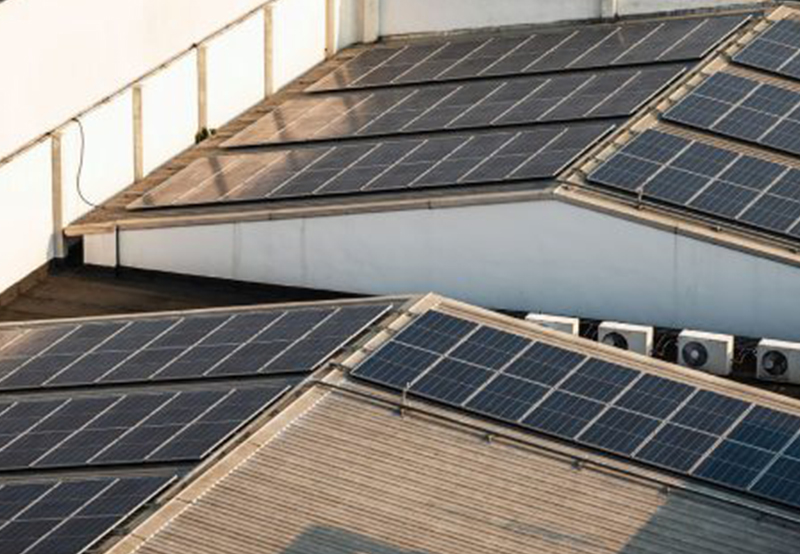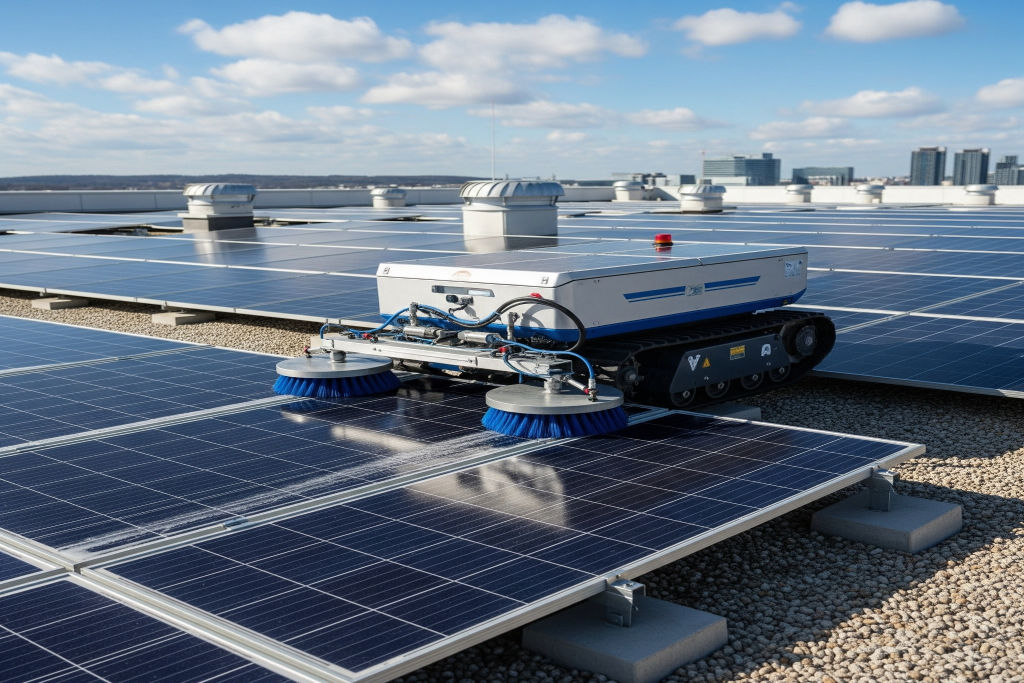Why Robotic Solar Panel Cleaning is the Future of Solar Maintenance
In the renewable energy industry that is swiftly expanding today, solar energy is one of the most powerful leaders of sustainable development. But to keep solar panels operating at peak efficiency, regular and effective solar panel maintenance is a must. That’s where robotic solar panel cleaning steps in—offering a smart, automated solution to a traditionally manual task.

Solar panel cleaning robots are transforming the way we maintain solar installations. These robots enhance energy production not only because they do not produce dust and debris manually, but because this results in an expanded solar system lifespan. In our article, we will learn about the functioning of that innovative technology, its main advantages, and how it is becoming the most popular means of managing solar farms worldwide.
Why Clean Solar Panels?
The need to clean the solar panels on a regular basis is an important aspect to be understood before venturing into developing strategies of automating them.
The solar panels are set on open areas preferably on rooftops, deserts, or spread out fields where they get exposed to dust, pollen, bird droppings, and pollution. Eventually, they build up on the surface and prevent sunlight hence lowering the efficiency of the panels greatly. Indeed, it has been found that dirty panels lose as much as 30% of their energy generation capacity.
That is where regular cleaning is obligatory. Nevertheless, using manual cleaning methods, particularly gross-scale solar plants or inaccessible platforms on rooftops, is cumbersome, expensive and usually risky to perform. The need for a smarter solution led to the rise of automated solar panel cleaning systems.
The Rise of Robotic Solar Panel Cleaning
Effective solar panel cleaning used to be carried out by hoses, detergents, brush and labor. Such an approach, though efficient in the short-run perspective, entails numerous issues, namely, water wastage, time spending, the high cost of operations, and the possibility of possible panel damage caused by its inappropriate handling.
With the rise of robotic solar panel cleaning systems, the game has changed.
These robots are engineered specifically for solar panel maintenance, using soft-bristled brushes, microfibers, and in many cases, waterless technology. They move on panel surfaces through suction or wheel mechanisms and remove dirt in a regular manner without any kind of scratch or harm to the fragile components.
How Solar Panel Cleaning Robots Work
A solar panel cleaning robot is designed with various technologies depending on the complexity and scale of the solar system. Here’s a breakdown of how these robots typically function:
- Mobility Systems: Most robots use rail-mounted systems or autonomous navigation to move across solar panels.
- Brush or Wiper Mechanism: Gentle yet effective cleaning brushes rotate or swipe across the panel surface.
- Water-based or Waterless Cleaning: Some use minimal water with filters, while others rely solely on dry cleaning technologies to conserve water—ideal for desert or arid installations.
- Sensors and AI Integration: Advanced models include AI-based sensors to detect the level of dirt and adjust cleaning intensity accordingly.
- Remote Operation: Most robotic systems can be operated via mobile apps or control units, allowing real-time tracking and scheduling of cleaning operations.
Advantages of Robotic Solar Panel Cleaning
Implementing a robotic solar panel cleaning system offers a variety of benefits over traditional cleaning methods:
- Water Conservation: Solar panel cleaning robots are often designed to work without water which saves on consumption of water particularly in the arid areas where there is little water availability.
- Enhanced Efficiency: The clearest outcome is that optimal light absorption can be achieved through regular, accurate cleaning that will result in the highest energy output. Energy savings as high as 15-30% have been reported following robotic cleaning.
- Lower Operating Costs: Although the initial investment cost of a robot can be regarded as expensive, the cost implications of labour, downtime, and water in the long run yield very high returns to the investment by reducing the costs.
- Time-Saving: Automation saves a lot of time in cleaning large solar farms. Robots may clean at low times or even at night without creating interference to energy production.
- Safety: Robotic systems replace human labor in hazardous situations such as sloping rooftops or large utility-scale solar installations.
- Scalability: When the solar farms are large, their cleaning with the use of hands loses its efficiency. Robotics are scalable and programmable to large-scale activities easily.
Types of Robotic Solar Panel Cleaning Systems
There are various types of cleaning robots available, each suited for specific installations:
- Fixed Rail-Mounted Robots: Ideal for utility-scale solar farms with aligned panels. These robots move across rails installed along rows of panels and can operate autonomously at set intervals.
- Portable Cleaning Robots: These are lightweight and manually placed onto panel rows. Suitable for residential or smaller commercial installations, these robots often come with battery packs and require minimal setup.
- Self-Charging Robots: Solar-powered themselves, these robots charge during the day and clean at night. This is particularly efficient for off-grid or remote installations.
Industries and Applications
Robotic solar panel cleaning is being adopted in diverse environments:
- Residential Rooftops: Homeowners are investing in portable cleaning bots to maintain energy efficiency and extend panel life.
- Commercial Buildings: Offices and factories with rooftop installations benefit from automated cleaning, minimizing disruptions.
- Solar Farms: Utility-scale solar farms are the biggest beneficiaries, where miles of solar panels demand regular cleaning for peak output.
- Remote Installations: In deserts or remote areas with no water access, waterless cleaning robots offer unmatched advantages.
Environmental Impact
While solar energy itself is green, solar panel maintenance processes must also be environmentally conscious. Robotic systems:
- Reduce water consumption.
- Eliminate the need for chemical detergents.
- Lower carbon footprint by reducing the need for transportation and manual labor.
- Operate using solar power or rechargeable batteries.
By using a solar panel cleaning robot, operators contribute not only to better energy output but also to more sustainable solar practices.
Challenges and Considerations
Though promising, robotic solar panel cleaning is not without its challenges:
- Initial Investment: The cost of a robotic system may deter smaller installations. However, costs are steadily falling with wider adoption and mass production.
- Customization Needs: Different panel orientations, spacing, and layouts may require custom solutions or modifications.
- Maintenance of the Robot: Like any mechanical system, these robots need their own maintenance schedule to ensure consistent performance.
- Weather Dependency: Extreme weather conditions like heavy winds or snowfall can limit robotic operations and require backup cleaning strategies.
The Future of Automated Solar Panel Cleaning
The global demand for renewable energy continues to rise, and with it, the importance of maintenance and efficiency. As technology matures, automated solar panel cleaning is expected to become standard across installations of all sizes.
Future trends to watch include:
- AI-Powered Cleaning: More intelligent robots that analyze dirt levels and optimize cleaning routes.
- Drones for Inspection + Cleaning: Combining aerial inspection and lightweight cleaning via drones.
- Integration with Solar Monitoring Software: Systems that trigger cleaning cycles based on performance drops.
- Collaborative Robots (Cobots): Machines that can work alongside humans for hybrid cleaning tasks.
These advancements will further cement robotic solar panel cleaning as an integral part of solar O&M (Operations and Maintenance) strategies.
Conclusion
The shift to renewable energy goes beyond just setting up solar panels—it’s about caring for them in a smarter, more sustainable way. That’s where robotic solar panel cleaning systems come in. These innovative tools are changing the game, offering an eco-friendly and efficient solution to keep solar panels performing at their best. With solar panel cleaning robots, there’s less water waste, reduced labor, and improved energy output. As automation becomes more affordable, automated solar panel cleaning is quickly becoming a standard—whether on home rooftops or vast solar farms—guiding us toward a cleaner, more efficient energy future.
Frequently Asked Questions (FAQs)
Absolutely. By minimizing water use and eliminating the need for chemical cleaners or fuel-powered tools, robotic solar panel cleaning supports sustainable and green energy practices.
No, quality solar panel cleaning robots are engineered with soft, non-abrasive materials and smart navigation to clean without scratching or damaging the panels.
While the initial investment in a robotic solar panel cleaning system may be higher than manual methods, it pays off over time through improved efficiency, reduced labor costs, and water savings.
Cleaning frequency depends on location and environmental conditions. In dusty or industrial areas, panels may need cleaning every few weeks. Robotic systems can be scheduled to clean at optimal intervals automatically.
Yes. Smaller, portable solar panel cleaning robots are designed for residential rooftops and can be operated easily by homeowners or local technicians.












